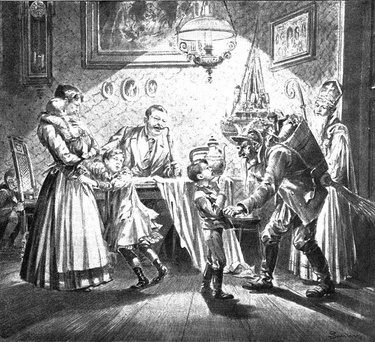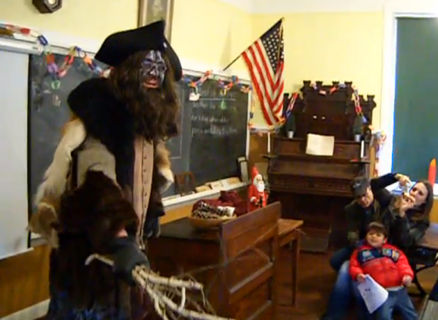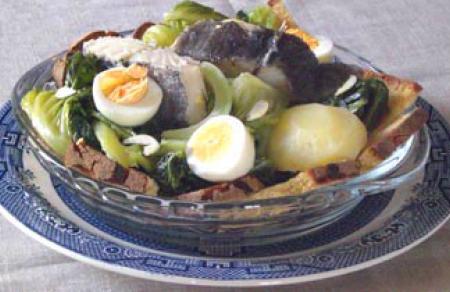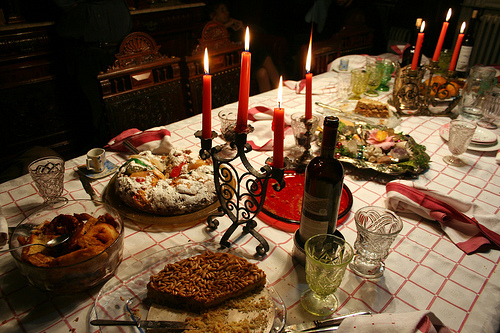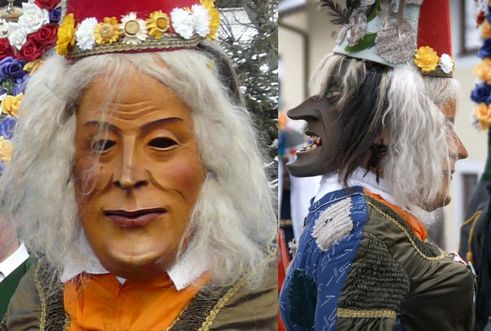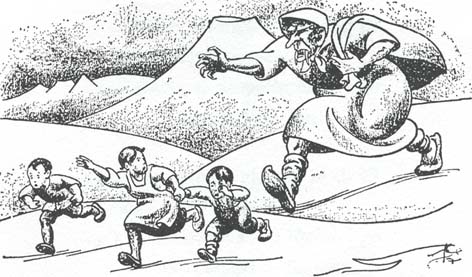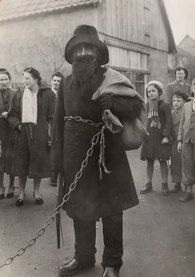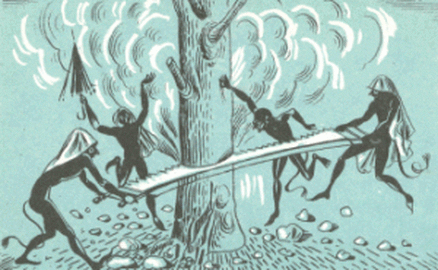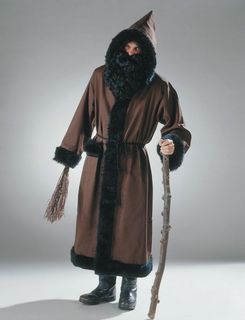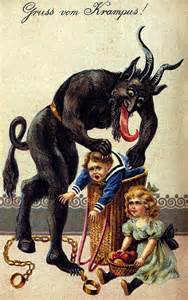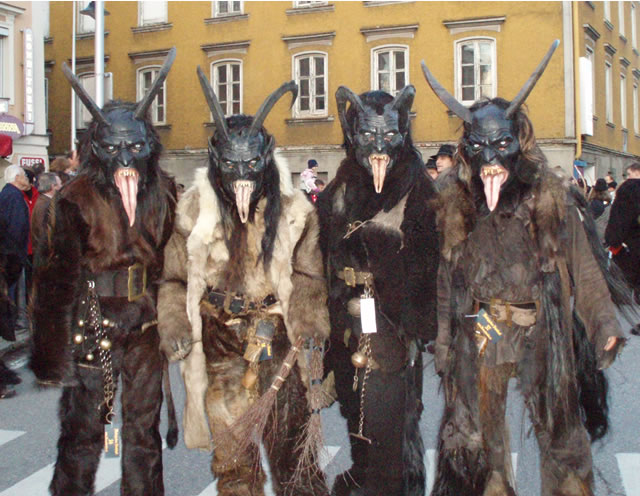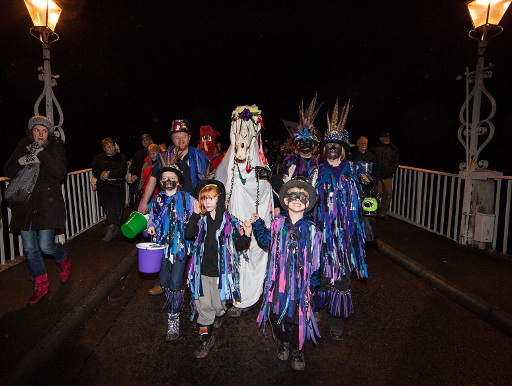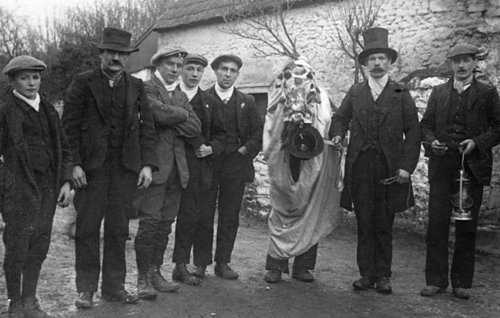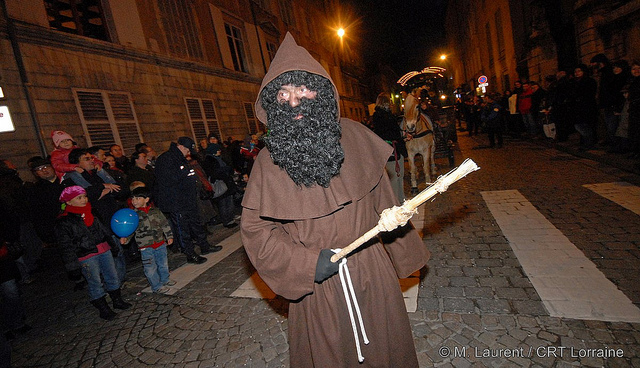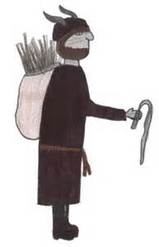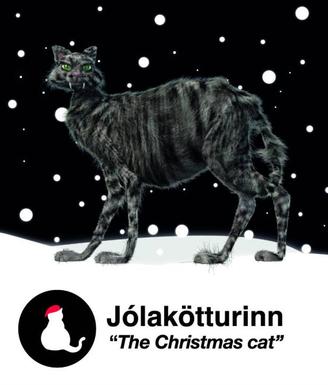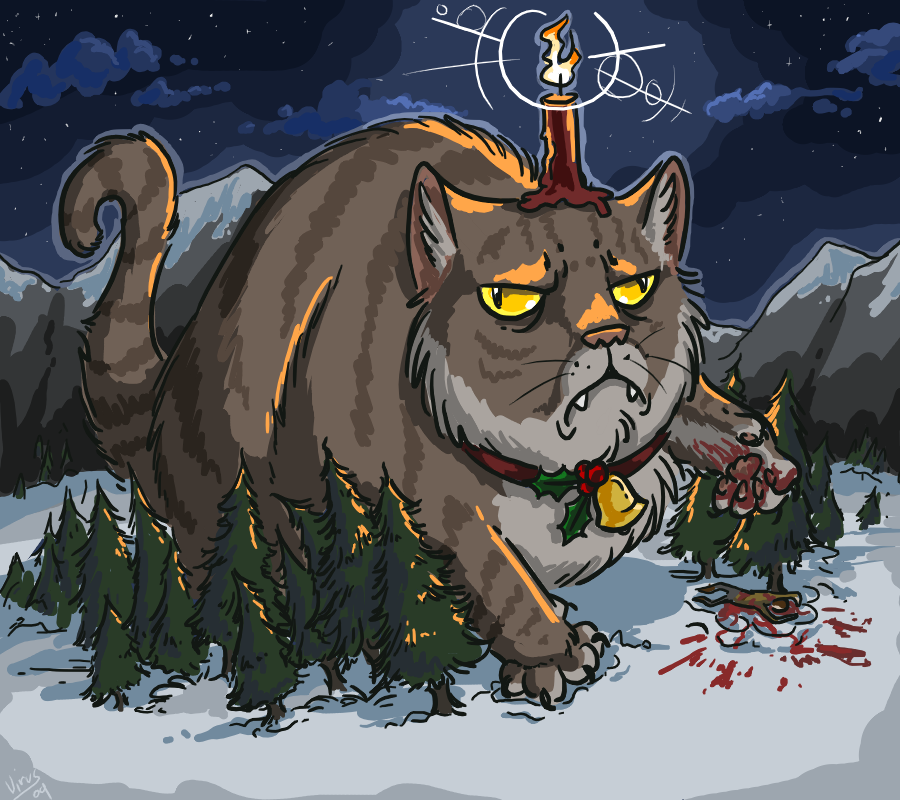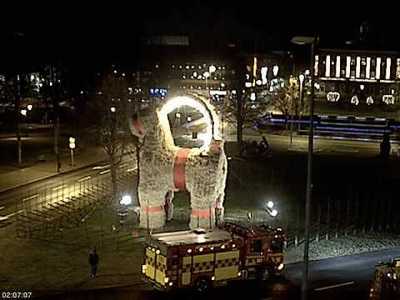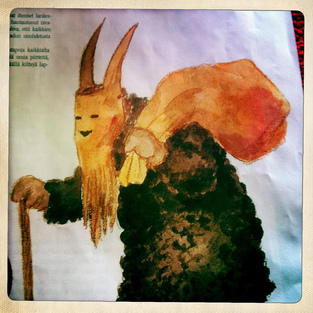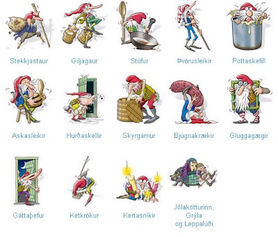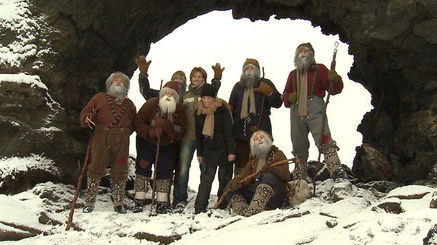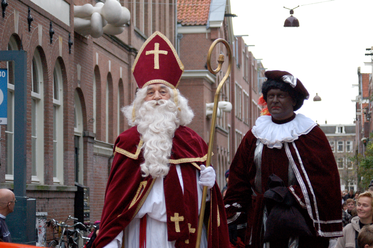Christmas Lore and myths from around the world.
We have come across some great stories about being related to Christmas in our internet travels and wanted to share them with you. Feel free to drop us a message regarding any of these stories via our contact email, or a message on our Facebook page. Enjoy!!!!
Belsnickel - PA Dutch ( Amish) via Germany
Originally from thew Palentine region of Germany, He is also preserved in PA Dutch communities. The Belsnickel shows up at houses 1–2 weeks before Christmas, looking very ragged and mean dressed in brown furs.. He knows exactly which of the children misbehaved. Traditionally he would use the switch to punish past wrong or the threat of the switch to ensure good behavior till Christmastime. In addition to his torn, tattered clothes he carries a switch in his hand with which to beat bad children. The children escape unharmed, but they are scared into being good so that Santa will bring them presents on Christmas
When he visits the homes to check up on children he announces his presence with a loud rap on the door or window with his stick and often the children would have to answer a question for him or sing some type of song. If they were good and answered well, he would toss candies onto the floor. However if the children jumped too quickly for the treats, they may end up getting a smack from the switch for being too greedy.
All-in-all this figure is not as bad as some of the anti-Santas out there, more of a enforcer than mean or evil. I assume you would have a different outlook on this if you had been one switched a time or two. This legend fell out of favor after the Civil War and the popularization of the current Santa Clause in the post Civil War era.
When he visits the homes to check up on children he announces his presence with a loud rap on the door or window with his stick and often the children would have to answer a question for him or sing some type of song. If they were good and answered well, he would toss candies onto the floor. However if the children jumped too quickly for the treats, they may end up getting a smack from the switch for being too greedy.
All-in-all this figure is not as bad as some of the anti-Santas out there, more of a enforcer than mean or evil. I assume you would have a different outlook on this if you had been one switched a time or two. This legend fell out of favor after the Civil War and the popularization of the current Santa Clause in the post Civil War era.
Consoada - Portugal
In the early hours of Christmas day morning, usually right after the Midnight Mass ("Missa do Galo" Mass of the Rooster) the family goes home to the Consoada. This is a traditional feast usually consisting of codfish with boiled potatoes, cabbage, hard boiled eggs and kale. Afterwards they eat traditional desserts, which vary from region to region.
One of the interesting traditions of the Feast is that they set extra place for the Alminhas a Penar ( "the souls of the dead"). In some areas crumbs are left on the hearth for these souls, a custom that derives from the ancient practice of entrusting seeds to the dead in hopes that they will provide a bountiful harvest. Souls are given food gift with the hope of doing well in future.
Some traditions hold that after eating this late light meal the table is left as is and the dishes are traditionally not done – in respect to the dead family members that may join in later and eat the leftovers or waiting for baby Jesus.
Many newer traditions is to do the gift exchange right after the feast, which is a way also encourages the souls of the dead to participate.
I would love to know more about this tradition, as it is a great way to bring current and past family members into the holiday celebrations. If any of our Portuguese readers have anything to share, we at Nightwatch Paranormal are all ears.
One of the interesting traditions of the Feast is that they set extra place for the Alminhas a Penar ( "the souls of the dead"). In some areas crumbs are left on the hearth for these souls, a custom that derives from the ancient practice of entrusting seeds to the dead in hopes that they will provide a bountiful harvest. Souls are given food gift with the hope of doing well in future.
Some traditions hold that after eating this late light meal the table is left as is and the dishes are traditionally not done – in respect to the dead family members that may join in later and eat the leftovers or waiting for baby Jesus.
Many newer traditions is to do the gift exchange right after the feast, which is a way also encourages the souls of the dead to participate.
I would love to know more about this tradition, as it is a great way to bring current and past family members into the holiday celebrations. If any of our Portuguese readers have anything to share, we at Nightwatch Paranormal are all ears.
Frau Perchta - Germany
In the Alpine countries of southern Germany “Frau Perchta” or “the bright one” appears during midwinter around the feast of the epiphany. She either appears as a beautiful woman as white as snow, or as a haggard old crone.
She overseas spinning and is often seen with one human foot and swan’s foot. This is apparently due to her inability to fully disguise herself as a higher being.
In the folklore, Perchta was said to roam the countryside at midwinter between the twelve days between Christmas and Epiphany. She would enter the homes and know whether the children had behaved and young servants of the household worked hard all year. If they had, she would leave a small silver coin next day in a shoe or pail. For those who did not please her, she would slit their bellies open to remove the stomach and guts. She would then stuff the body cavity with straw and pebbles. Her major concern was if the young girls had spun the whole of their allotted portion cloth from flax or wool during the year. She would also slit the bellies of those who did not honor here on her feast day by eating the traditional meal of fish and gruel.
Her feast day is December 31st. So if you find yourself in the Germanys on New Year’s eve, have yourself some fishy gruel at some point of the day, you can always wash it down with beer and dream of the pork and sauerkraut on new years day.
She overseas spinning and is often seen with one human foot and swan’s foot. This is apparently due to her inability to fully disguise herself as a higher being.
In the folklore, Perchta was said to roam the countryside at midwinter between the twelve days between Christmas and Epiphany. She would enter the homes and know whether the children had behaved and young servants of the household worked hard all year. If they had, she would leave a small silver coin next day in a shoe or pail. For those who did not please her, she would slit their bellies open to remove the stomach and guts. She would then stuff the body cavity with straw and pebbles. Her major concern was if the young girls had spun the whole of their allotted portion cloth from flax or wool during the year. She would also slit the bellies of those who did not honor here on her feast day by eating the traditional meal of fish and gruel.
Her feast day is December 31st. So if you find yourself in the Germanys on New Year’s eve, have yourself some fishy gruel at some point of the day, you can always wash it down with beer and dream of the pork and sauerkraut on new years day.
Grýla - Iceland
In the island nation of Iceland lived an ogre named Grýla. She has a husband ( her third) who is a troll named Leppalúði. She also has a fiendish cat called the Yule Cat. But this crazy cat lady also has the Yule Lads.
They are her thirteen mischievous sons, Not sure which belong to which father though. Grýla, herself has a horrible appearance. Grýla has hooves and horns and tail and she was overall very ugly. She also has a habit of boiling and eating children she had kidnapped. In her defense she only does that to bad children. She would use her supernatural sense of hearing to listen for misbehaving children all around the island. Around midwinter ( Christmas time ) she could leave her cave and collect the misbehaving children. In a twist, the kidnapped children could repent of their deeds and not be eaten.
Her story was so effective in traumatizing children into behaving that in 1746 a decree was adopted by the government to prohibit the use of the story. Today she is most likely still munching away with her large family. You figure only a food source as plentiful as misbehaving children could feed so many mouths. More on the Yule Cat and the Yule lads under other headings.
They are her thirteen mischievous sons, Not sure which belong to which father though. Grýla, herself has a horrible appearance. Grýla has hooves and horns and tail and she was overall very ugly. She also has a habit of boiling and eating children she had kidnapped. In her defense she only does that to bad children. She would use her supernatural sense of hearing to listen for misbehaving children all around the island. Around midwinter ( Christmas time ) she could leave her cave and collect the misbehaving children. In a twist, the kidnapped children could repent of their deeds and not be eaten.
Her story was so effective in traumatizing children into behaving that in 1746 a decree was adopted by the government to prohibit the use of the story. Today she is most likely still munching away with her large family. You figure only a food source as plentiful as misbehaving children could feed so many mouths. More on the Yule Cat and the Yule lads under other headings.
Hans Trapp - Alsace and Lorraine regions of France
Hans Trapp was an actual person who lived from 1450 to 1503 named Hans von Trotha . He was a knight under the patronage of the elector of Palatine. Due to his service he was awarded several castles and properties. However some of said properties were also claimed by the Abbot of Wissembourg.
In short order the dispute turned into a feud, which turned into open warfare. The Abbot turned to the Holy Roman Emperor and the Pope, both of whom Hans Ignored. Hans was excommunicated and he was seen as the quintessential robber baron.
He was eventually turned into the Black Knight of the area to frighten children. Later on he became associated with Saint Nickolas as one of his companions, whom punished the misbehaving children, not unlike the figure of Knecht Ruprecht in other areas of the Germanys.
In short order the dispute turned into a feud, which turned into open warfare. The Abbot turned to the Holy Roman Emperor and the Pope, both of whom Hans Ignored. Hans was excommunicated and he was seen as the quintessential robber baron.
He was eventually turned into the Black Knight of the area to frighten children. Later on he became associated with Saint Nickolas as one of his companions, whom punished the misbehaving children, not unlike the figure of Knecht Ruprecht in other areas of the Germanys.
Kallikantzaroi - Greece
There is a belief in Southeastern Europe and Turkey of the existence of a race of underground goblins called the Kallikantzaroi. They spend the year sawing the roots of the World Tree trying to bring it to collapse and destroy the earth. Right as they are about to finish the 12 days of Christmas come about.
This is the only time of the year they can come to the surface and torment humans, so they abandon their sawing and head to the surface. In their absence, the world tree heals itself and the cycle starts anew after the 12 day.
As they are on the surface tormenting humans, it is important to know how to protect yourself if you happen to be in the area during this time. One way is to leave a colander on their doorstep. As they cannot count to 3 ( it is a holy number) they will spend all night on the doorstep counting up to 2. Another method of protection was to leave the Yule Log or a fire burning in the fireplace so that they cannot enter through there. Some area add smelly shoes to the fire as an added deterrent. Another way to keep them away is to mark your door with a black cross on Christmas Eve and burn incense.
Knecht Ruprecht - Germany
In the lands of the Holy Roman Empire of old, there is a series of companions whom travel with St Nickolas, one of these is known as Knecht Ruprecht.
Knecht was a foundling found and raised by St Nickolas. Often riding on a white horse, Knecht Ruprecht sometimes carries a long staff and a bag of ashes, and wears little bells on his clothes. In some traditions he is accompanied by fairies. Some traditions use men with blackened faces dressed as old women in place of fairies.
In almost all traditions Knecht Ruprecht asks children whether they can pray. If they can, they receive apples, nuts, and gingerbread. If they cannot, he beats the children with his bag of ashes. More modern times has Knecht Ruprecht giving naughty children lumps of coal or sticks and stones. The stick is for the parents to beat them with. Well behaving children receive sweets from Saint Nicholas.
Knecht was a foundling found and raised by St Nickolas. Often riding on a white horse, Knecht Ruprecht sometimes carries a long staff and a bag of ashes, and wears little bells on his clothes. In some traditions he is accompanied by fairies. Some traditions use men with blackened faces dressed as old women in place of fairies.
In almost all traditions Knecht Ruprecht asks children whether they can pray. If they can, they receive apples, nuts, and gingerbread. If they cannot, he beats the children with his bag of ashes. More modern times has Knecht Ruprecht giving naughty children lumps of coal or sticks and stones. The stick is for the parents to beat them with. Well behaving children receive sweets from Saint Nicholas.
Krampus - Austria
Krampus is a beast-like creature, who appears in many demonic variations. Most share hairy, brown or black, horns of a goat, and has cloven hooves. His tongue is long and pointed. He often carries chains ( which symbolize the binding of the devil) which he rattles for dramatic effect. He will often carry birch branches, called ruten, to swat misbehaving children. some representations replace the ruten with a whip. Many times he will have a sack or basket to carry misbehaving children back to his lair or to hell depending on the telling. He sometimes eats the children as well..
People dress up as Krampus during the evening of 5 December (Eve of the feast of St Nicholas) and roam frightening children and most likely some adults, as alcohol is often involved. It is customary to offer a Krampus Schnapps. The following day St Nicholas and Krampus will go door to door. St Nick will give presents to the good children, Krampus will use the switch upon the bad ones.
Originally from the alps areas of Austria, the practice spread with the Hapsburg Empire. The practice pre dates Christianity, as the Krampus is often seen as a form of horned one.
A slightly different approach is this myth is one where children leave their shoes outside their door overnight from the 5th to the 6th of December. If they have been good, St Nick puts candy in the shoe. If they have been bad, Krampus places coal and sticks into their shoes.
People dress up as Krampus during the evening of 5 December (Eve of the feast of St Nicholas) and roam frightening children and most likely some adults, as alcohol is often involved. It is customary to offer a Krampus Schnapps. The following day St Nicholas and Krampus will go door to door. St Nick will give presents to the good children, Krampus will use the switch upon the bad ones.
Originally from the alps areas of Austria, the practice spread with the Hapsburg Empire. The practice pre dates Christianity, as the Krampus is often seen as a form of horned one.
A slightly different approach is this myth is one where children leave their shoes outside their door overnight from the 5th to the 6th of December. If they have been good, St Nick puts candy in the shoe. If they have been bad, Krampus places coal and sticks into their shoes.
Mari Lwyd - Wales
The Mari Lwyd (or Grey Mare or Mary) consists of a mare's ( female horse) skull suspended on a wooden pole. A white sheet is attached to the skull and hides the pole and person carrying it. Often two black ears are attached to the skull and green bottle ends fill the eye sockets. The skulls lower jaw is often spring loaded so the Mari Lwyd can snap at passers by.
The Mari party consists of five or Six people who wear a broad sash around thier waist and have colored ribbons attached to thier clothing. The leader usually carries a staff, stick or a whip. Punch who is usually in bright dress and blackface and carries a long metal poker. Judy is usually a man again in blackface and carries a broom. The rest of the Merrymen play the music on thier instraments.
This Welsh tradition is a lot like Christmas caroling. The party consists of You go from house to house (pubs included) singing traditional songs and having riddle contests( called Pwnco) to gain entry into the building. The mare party entering a building is a good luck rite, so they are not often refused.
Once inside the Merrymen make music, Punch tries to kill all the girls, Judy tries to hit Punch with her broom, the Mare tries to bite people and the Leader tries to stop the Mare from biting people. In certain villages Punch would also pull out and put out the Hearth fire with his poker, unless he had promised not to do so before admittance. Judy would often sweep the coals and cinders aroundcausing quite the mess.
Most of the activities of the party are lighthearted and they are often rewarded with food, drink and sometimes money prior to singing the traditional farewell song and heading to the next place.
This tradition is thought to be from an ancient rite for the Celtic goddess Rhiannon. The tradition died out during the Industrial Revalution and temperance movements of the 1800's. The practice was kept alive in the south and south east of Wales. Recently the intrest in Welsh culture has causes a resurgence of this ancient practice.
The Mari party consists of five or Six people who wear a broad sash around thier waist and have colored ribbons attached to thier clothing. The leader usually carries a staff, stick or a whip. Punch who is usually in bright dress and blackface and carries a long metal poker. Judy is usually a man again in blackface and carries a broom. The rest of the Merrymen play the music on thier instraments.
This Welsh tradition is a lot like Christmas caroling. The party consists of You go from house to house (pubs included) singing traditional songs and having riddle contests( called Pwnco) to gain entry into the building. The mare party entering a building is a good luck rite, so they are not often refused.
Once inside the Merrymen make music, Punch tries to kill all the girls, Judy tries to hit Punch with her broom, the Mare tries to bite people and the Leader tries to stop the Mare from biting people. In certain villages Punch would also pull out and put out the Hearth fire with his poker, unless he had promised not to do so before admittance. Judy would often sweep the coals and cinders aroundcausing quite the mess.
Most of the activities of the party are lighthearted and they are often rewarded with food, drink and sometimes money prior to singing the traditional farewell song and heading to the next place.
This tradition is thought to be from an ancient rite for the Celtic goddess Rhiannon. The tradition died out during the Industrial Revalution and temperance movements of the 1800's. The practice was kept alive in the south and south east of Wales. Recently the intrest in Welsh culture has causes a resurgence of this ancient practice.
Père Fouettard -(Father Whipper) France
France 1150 AD, an innkeeper and his wife capture three wealthy boys on their way to enroll in a religious boarding school. They kill the children in order to rob them. They drug the children, slit their throats, cut them into pieces, and stew them in a barrel. St. Nicholas discovers the crime and resurrects the children. Père Fouettard is forced by Saint Nickolas to become his assistant as a punishment for his crimes.
The most common depiction of Le Père Fouettard would be of a man with a sinister face dressed in dark robes with scraggly unkempt hair and a long beard. Often he is dressed identical to St Nickolas His face is black from the soot of going down chimneys with St. Nickolas. He is armed with either a whip, a large stick, or with bundles of switches. He sometimes wears a wicker back pack to carry away misbehaving children.
In the 1930s, Father Flog appeared in the United States. Father Flog is almost identical to the being known as Père Fouettard. Father Flog and his wife Mother Flog have no connection to Christmas. They go around year round and dole out punishments for childhood crimes.
The most common depiction of Le Père Fouettard would be of a man with a sinister face dressed in dark robes with scraggly unkempt hair and a long beard. Often he is dressed identical to St Nickolas His face is black from the soot of going down chimneys with St. Nickolas. He is armed with either a whip, a large stick, or with bundles of switches. He sometimes wears a wicker back pack to carry away misbehaving children.
In the 1930s, Father Flog appeared in the United States. Father Flog is almost identical to the being known as Père Fouettard. Father Flog and his wife Mother Flog have no connection to Christmas. They go around year round and dole out punishments for childhood crimes.
Yule Cat - Iceland
Not to be outdone by their cousins on the peninsula ( see Yule Goat post), the people of Iceland have their own Yule Beastie - the Yule Cat. Aka the Jólakötturinn or Jólaköttur. Those crazy nordic peoples and their spelling.
The yule cat is not some cute lovable cuddly kitty. O No, the Yule Cat is a huge and vicious cat that wanders about the countryside and devouring people who did not get new clothes before Yuletide. Specifically by Christmas Eve. Jólakötturinn is always portrayed as an enormous black cat, with sharp whispers, long claws and fang-like teeth.
There seems to be evidence the The Yule Cat prowled around during the dark ages, however The Yule cat story was not written down and popularized until the 19th century. The threat of being eaten by the Yule Cat was used by farmers as an incentive for their workers to finish processing the autumn wool before Christmas. The ones who took part in the work would be rewarded with new clothes, but otherwise get nothing and thus be preyed upon by the monstrous cat. Parents would also use this cat as a way to get children to do their chores, to earn new articles of clothing so as not to get devoured by the prowling feline.
Jólakötturinn is thought to have been the pet of the evil troll Grýla, her husband, Leppalúði and the thirteen Yule-lads, who all lived in a mountain top cave. However their is no certainty about it's origin. The Nordic poet with an unpronounceable name Jóhannes úr Kötlum wrote a famous poem about the cat. In it he states "no one knows where he’s from or where he goes”. If we can find a translation of this work, it will be posted. However as he was quoted as saying " You'll have to forgive me but I didn't make it rhyme - I'm not much of a poet.", we don't have high hopes.
There is a tradition Yule Cat will consume the Christmas food of people who have not received the prerequisite new clothing. Some sources put that as the earlier form of the cat and some place it as the more recent cat shenanigans. I am not sure which activity the Yule cat engages in currently, however either way I'm glad I got a new Santa hat with bells this year.
Please note, the Cat appears to have a Facebook page with about 160 likes.... check him out, if you dare!!!!!
The yule cat is not some cute lovable cuddly kitty. O No, the Yule Cat is a huge and vicious cat that wanders about the countryside and devouring people who did not get new clothes before Yuletide. Specifically by Christmas Eve. Jólakötturinn is always portrayed as an enormous black cat, with sharp whispers, long claws and fang-like teeth.
There seems to be evidence the The Yule Cat prowled around during the dark ages, however The Yule cat story was not written down and popularized until the 19th century. The threat of being eaten by the Yule Cat was used by farmers as an incentive for their workers to finish processing the autumn wool before Christmas. The ones who took part in the work would be rewarded with new clothes, but otherwise get nothing and thus be preyed upon by the monstrous cat. Parents would also use this cat as a way to get children to do their chores, to earn new articles of clothing so as not to get devoured by the prowling feline.
Jólakötturinn is thought to have been the pet of the evil troll Grýla, her husband, Leppalúði and the thirteen Yule-lads, who all lived in a mountain top cave. However their is no certainty about it's origin. The Nordic poet with an unpronounceable name Jóhannes úr Kötlum wrote a famous poem about the cat. In it he states "no one knows where he’s from or where he goes”. If we can find a translation of this work, it will be posted. However as he was quoted as saying " You'll have to forgive me but I didn't make it rhyme - I'm not much of a poet.", we don't have high hopes.
There is a tradition Yule Cat will consume the Christmas food of people who have not received the prerequisite new clothing. Some sources put that as the earlier form of the cat and some place it as the more recent cat shenanigans. I am not sure which activity the Yule cat engages in currently, however either way I'm glad I got a new Santa hat with bells this year.
Please note, the Cat appears to have a Facebook page with about 160 likes.... check him out, if you dare!!!!!
Yule Goat - Scandinavia
The Yule Goat is a Scandinavian tradition that predates the arrival of Christianity in Northern Europe. Call him the julbock (Sweden), julebukk (Norway), or joulupuuki (Finland), he's been part of Scandinavian mid-winter celebrations for more than one thousand years. Of course we at NightWatch Paranormal just learned of it, and had to share.
The goat was a symbol of the Norse god Thor, whose flying chariot was pulled by two goats. When entertaining the other gods, Thor would kill his goats to feed his guests and then resurrect them afterwards, using his hammer Mjöllnir. In Sweden, a Christmas custom based on this tale of Thor is still performed. In the Juloffer, or Yule Sacrifice, two actors sacrifice a third actor who is dressed as a goat while singing a song. At the end of the song, the goat is resurrected.
Originally the Yule Goat was seen a a spirit who would go about making sure people were completing their Yule preparations. The Goat also would demand gifts from people. In the mid 19th century the Yule Goat started to be a bringer of gifts, but this role has been taken over by Father Christmas. Still later, instead of giving presents the Yule Goat worked for those who brought them. Gnome-like, gift-giving Swedish tomten, Norwegian nissen, and Finnish tonttu all rode Yule goats or hitched them to their sleds.
The Yule Goat is today most commonly seen as a Christmas ornament, usually made out of straw. Many towns in Sweden erect a giant-sized version of the straw Yule Goat at Christmas. These highly flammable displays are an attractive target for pranksters and vandals. The 43-foot-tall goat in Gälve, Sweden, has been burnt down 38 of the 47 years since it was first erected in 1966. Despite being guarded by webcams since 1996, the vandals still manage to burn it down. They got the goat 4 days before Christmas this year, so it is on for 2014.
The goat was a symbol of the Norse god Thor, whose flying chariot was pulled by two goats. When entertaining the other gods, Thor would kill his goats to feed his guests and then resurrect them afterwards, using his hammer Mjöllnir. In Sweden, a Christmas custom based on this tale of Thor is still performed. In the Juloffer, or Yule Sacrifice, two actors sacrifice a third actor who is dressed as a goat while singing a song. At the end of the song, the goat is resurrected.
Originally the Yule Goat was seen a a spirit who would go about making sure people were completing their Yule preparations. The Goat also would demand gifts from people. In the mid 19th century the Yule Goat started to be a bringer of gifts, but this role has been taken over by Father Christmas. Still later, instead of giving presents the Yule Goat worked for those who brought them. Gnome-like, gift-giving Swedish tomten, Norwegian nissen, and Finnish tonttu all rode Yule goats or hitched them to their sleds.
The Yule Goat is today most commonly seen as a Christmas ornament, usually made out of straw. Many towns in Sweden erect a giant-sized version of the straw Yule Goat at Christmas. These highly flammable displays are an attractive target for pranksters and vandals. The 43-foot-tall goat in Gälve, Sweden, has been burnt down 38 of the 47 years since it was first erected in 1966. Despite being guarded by webcams since 1996, the vandals still manage to burn it down. They got the goat 4 days before Christmas this year, so it is on for 2014.
Yule Lads - Iceland
The number and activities of the Yule lads varied from area to area throughout Iceland’s history. In 1932 the poet Jóhannes úr Kötlum published a collection of poetry called "Jólin Koma" ("Christmas Arrives". In this popular compilation the work "Jólasveinarnir" was included, which set the names, and number of the Yule Lads in the national consciousness.
The Yule Lads were originally portrayed as being mischievous who would steal from, the population. They would also assist their mother in kidnapping misbehaving children for her to cook and eat. They all had descriptive names that conveyed their particular actions, and would each come on their assigned night. They too were part of the 1746 decree that forbade parents using the story to cowl children into behaving.
In more modern times they became more like Santa Clause, with each coming into town and leaving a gift in the shoe of good little boys and girls. Conversely if the child was bad the day before, they may just leave pieces of rotting potato. They started to give up their traditional garb, and each started to come dressed in a red suit even. In 1988 the National Museum invited the Yule lads to come and visit, buying them new clothes as they were all sharing the same red clothes and looking shabby. They now have more traditional garb in their annual appearance.
The lads are as follows:
Sheep-Cote Clod – 12t December
He used to try to suckle the yews in the farmers' sheep sheds.
Gully Gawk – 13th
He had a habit of stealing into the cowshed and slurping the foam off the milk in the buckets.
Stubby – 14th
He is also known as Pan Scraper because in the old days he used to try snatching bits of food from the frying pan.
Spoon Licker – 15th
In the past he would sneak into the houses and lick the wooden spoon used to scrape the pots.
Pot Scraper – 16th
He is also sometimes called Pot Licker since in the old days he waited to snatch away the pots that had not been washed and licked the food remains from the insides.
Bowl Licker – 17th
In the past, Icelanders ate from lidded wooden bowls that they sometimes kept under the bed or on the floor. Bowl Licker would hide under the bed, and if someone put their bowl on the floor he grabbed it and licked the inside clean.
Door Slammer – 18th
He always made a lot of noise when he walked around, slamming doors and such, so people could hardly get any rest.
Skyr Gobbler -19th
His favorite is an Icelandic dairy product called skyr, which is similar to yogurt. He likes it so much that he used to sneak into the pantry and gobble all the skyr out of the skyr tub.
Sausage Swiper- 20th
He loved to eat sausages and stole them whenever he had a chance.
Window Peeper -21st
He just liked to peep through the windows and sometimes nicked the toys that he saw.
Door Sniffer-22nd
He is easily recognized by his huge nose. He loved the smell of cakes and lace bread – sometimes called leaf bread – when they were being prepared for Christmas, and always tried to steal one or two.
Meat Hook- 23rd
Meat Hook was crazy about meat. In the old days he would lower a long stick through the chimney and snag a smoked leg of lamb hanging from the rafters, or a piece of smoked lamb from the pot. In those days the smoked lamb, which is traditional Icelandic Christmas fare, was cooked on St. Thorlák's Day.
Candle Beggar- 24th
In former times, candles were the brightest lights available to people. They were so rare and precious that all children longed to have their very own candle for Christmas. And poor Candle Beggar – well, he also longed for a candle.
The Yule Lads were originally portrayed as being mischievous who would steal from, the population. They would also assist their mother in kidnapping misbehaving children for her to cook and eat. They all had descriptive names that conveyed their particular actions, and would each come on their assigned night. They too were part of the 1746 decree that forbade parents using the story to cowl children into behaving.
In more modern times they became more like Santa Clause, with each coming into town and leaving a gift in the shoe of good little boys and girls. Conversely if the child was bad the day before, they may just leave pieces of rotting potato. They started to give up their traditional garb, and each started to come dressed in a red suit even. In 1988 the National Museum invited the Yule lads to come and visit, buying them new clothes as they were all sharing the same red clothes and looking shabby. They now have more traditional garb in their annual appearance.
The lads are as follows:
Sheep-Cote Clod – 12t December
He used to try to suckle the yews in the farmers' sheep sheds.
Gully Gawk – 13th
He had a habit of stealing into the cowshed and slurping the foam off the milk in the buckets.
Stubby – 14th
He is also known as Pan Scraper because in the old days he used to try snatching bits of food from the frying pan.
Spoon Licker – 15th
In the past he would sneak into the houses and lick the wooden spoon used to scrape the pots.
Pot Scraper – 16th
He is also sometimes called Pot Licker since in the old days he waited to snatch away the pots that had not been washed and licked the food remains from the insides.
Bowl Licker – 17th
In the past, Icelanders ate from lidded wooden bowls that they sometimes kept under the bed or on the floor. Bowl Licker would hide under the bed, and if someone put their bowl on the floor he grabbed it and licked the inside clean.
Door Slammer – 18th
He always made a lot of noise when he walked around, slamming doors and such, so people could hardly get any rest.
Skyr Gobbler -19th
His favorite is an Icelandic dairy product called skyr, which is similar to yogurt. He likes it so much that he used to sneak into the pantry and gobble all the skyr out of the skyr tub.
Sausage Swiper- 20th
He loved to eat sausages and stole them whenever he had a chance.
Window Peeper -21st
He just liked to peep through the windows and sometimes nicked the toys that he saw.
Door Sniffer-22nd
He is easily recognized by his huge nose. He loved the smell of cakes and lace bread – sometimes called leaf bread – when they were being prepared for Christmas, and always tried to steal one or two.
Meat Hook- 23rd
Meat Hook was crazy about meat. In the old days he would lower a long stick through the chimney and snag a smoked leg of lamb hanging from the rafters, or a piece of smoked lamb from the pot. In those days the smoked lamb, which is traditional Icelandic Christmas fare, was cooked on St. Thorlák's Day.
Candle Beggar- 24th
In former times, candles were the brightest lights available to people. They were so rare and precious that all children longed to have their very own candle for Christmas. And poor Candle Beggar – well, he also longed for a candle.
Zwarte Piet (Black Peter)- Netherlands
On the Feast of St Nickolas in the low countries of the Netherlands (Dec 5th), Belgium and Luxembourg (Dec 6th),St Nickolas distributes sweets and presents are to children.
He often arrives on a boat, which sailed from Madrid, Spain. Accompanying him are the Zwarte Pieten. They are said to be moors from Africa. The tasks of the Zwarte Pieten are mostly to amuse children, and to scatter pepernoten, kruidnoten and strooigoed (special sinterklaas candies) for those who come to meet the saint as he visits stores, schools, and other places.
Black Pete first makes his appearance in a book written in 1850 called Sint Nikolaas en zijn Knecht ("Saint Nicholas and his Servant"). This book not only introduces the Zwarte Piet character, but changes the St Nickolas character from a bit of a mean character to a more Santa Clause type character. He no longer punished the bad children, but just brought gifts to all.
Nowadays the Zwarte Piet has morphed into a series of helpers, one who performs each of the major functions needed. There is, of course, controversy surrounding this tradition. But that is beyond the scope of our story.
He often arrives on a boat, which sailed from Madrid, Spain. Accompanying him are the Zwarte Pieten. They are said to be moors from Africa. The tasks of the Zwarte Pieten are mostly to amuse children, and to scatter pepernoten, kruidnoten and strooigoed (special sinterklaas candies) for those who come to meet the saint as he visits stores, schools, and other places.
Black Pete first makes his appearance in a book written in 1850 called Sint Nikolaas en zijn Knecht ("Saint Nicholas and his Servant"). This book not only introduces the Zwarte Piet character, but changes the St Nickolas character from a bit of a mean character to a more Santa Clause type character. He no longer punished the bad children, but just brought gifts to all.
Nowadays the Zwarte Piet has morphed into a series of helpers, one who performs each of the major functions needed. There is, of course, controversy surrounding this tradition. But that is beyond the scope of our story.
